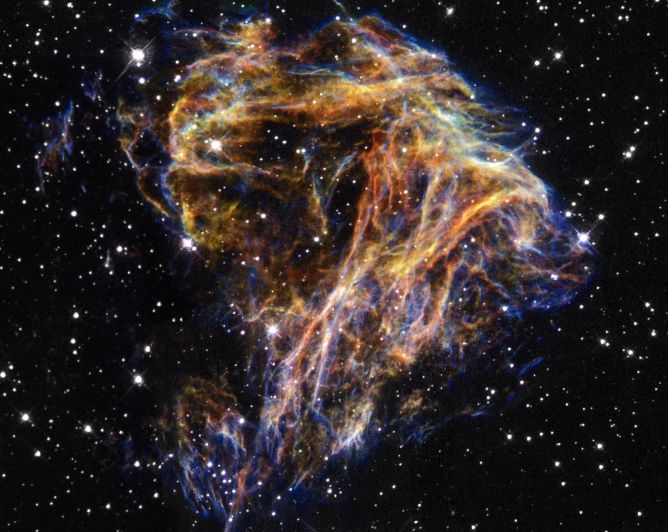
|
Explanation: Scattered debris from a cosmic supernova explosion lights up the sky in this gorgeous composited image based on data from the Hubble Space Telescope. Cataloged as N49, these glowing filaments of shocked gas span about 30 light-years in our neighboring galaxy, the Large Magellanic Cloud. Light from the original exploding star reached Earth thousands of years ago, but N49 also marks the location of another energetic outburst -- an extremely intense blast of gamma-rays detected by satellites only twenty-five years ago on March 5, 1979. That date was the beginning of an exciting journey in astrophysics which led researchers to the understanding of an exotic new class of stars. The source of the March 5th Event is now attributed to a magnetar - a highly magnetized, spinning neutron star also born in the ancient stellar explosion which created supernova remnant N49. The magnetar hurtles through the supernova debris cloud at over 1,200 kilometers per second.
|
January February March April May June July August September October November December |
| ||||||||||||||||||||||||||||||||||||||||||||||||
NASA Web Site Statements, Warnings, and Disclaimers
NASA Official: Jay Norris. Specific rights apply.
A service of: LHEA at NASA / GSFC
& Michigan Tech. U.
Based on Astronomy Picture
Of the Day
Publications with keywords: N 49 - magnetar - supernova remnant
Publications with words: N 49 - magnetar - supernova remnant
See also:
- APOD: 2026 January 7 Á Simeis 147: The Spaghetti Nebula Supernova Remnant
- APOD: 2025 October 1 Á NGC 6960: The Witchs Broom Nebula
- APOD: 2025 June 9 Á Between Scylla and Charybdis: A Double Cosmic Discovery
- Supernova Remnant Cassiopeia A
- APOD: 2025 January 8 Á Supernova Remnants Big and Small
- APOD: 2024 September 18 Á The Mermaid Nebula Supernova Remnant
- APOD: 2024 April 16 Á Filaments of the Vela Supernova Remnant
